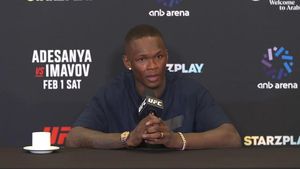LVMH Moët Hennessy Louis Vuitton, the world's largest luxury goods conglomerate, is experiencing a resurgence in its watches and jewelry division, marking a noteworthy recovery after several quarters of decline. Reports indicate sales increased by 3% during the latest quarter, a promising sign for the company's luxury market segment, particularly as American consumers drive this optimistic trend.
According to executives at LVMH, including Jean-Christophe Babin, CEO of Bulgari, the company has been positively surprised by the start of the year—a period often viewed as challenging for luxury retail. Babin noted, "I have to say I've been positively surprised by the start of the year," illustrating the unexpected increase amid prior struggles.
Consumer spending among affluent Americans, buoyed by renewed confidence following the U.S. presidential election, has emerged as the primary catalyst for this sales rebound. Anthony Ledru, CEO of Tiffany & Co., stated, "I think it brings clarity and probably a greater consumer confidence," underscoring the importance of consumer sentiment within the luxury market.
The luxury sector is not just resting on its laurels; LVMH brands are actively launching new products and strategies aimed at attracting higher spending clientele. For example, Louis Vuitton has unveiled innovative collections like the "Tambour Taiko Spin Time," which features jumping cubes inspired by traditional airport flap displays, and the stunning "Gentissima Oursin Fire Opal" from its Gérald Genta line, made with orange and red opal gems sourced from Mexican volcanoes.
While the U.S. market shines brightly, concerns about potential tariffs loom overhead, particularly those targeted at Swiss-made watches and French luxury items. The Trump administration previously hinted at tariff measures, which could unsettle the luxury goods market. Nevertheless, LVMH executives, accustomed to global tariff negotiations, remain confident. Babin added, "We have to wait and see what policies are announced before making plans; we're experienced with tariffs and duties globally."
The transformation of Tiffany's flagship storefront on Manhattan's Fifth Avenue highlights LVMH's commitment to upmarket strategies. Under significant investment, the store has been redesigned to feature high-end offerings and exclusive customer experiences. This effort has reportedly paid off, as Tiffany’s same-store sales surged by 9% during the fourth quarter. The introduction of luxury events, along with new product lines called "icons" based on historical designs, aims to cater to affluent customers seeking unique luxury items.
Antoine Pin, the CEO of TAG Heuer, speaks of the remarkable impact of their recent partnership with Formula 1, replacing Rolex as the official timekeeper. Pin noticed immediate positive reactions, stating, "My surprise was...any announcement we're making with F1 is immediately leading to significant reactions." This relationship emphasizes the intersection of luxury goods and high-octane sports, creating fresh opportunities for promotional strategies and consumer engagement.
A significant identity shift is also taking place within the luxury jewelry market. Babin remarked on the revolution brought about by the increasing financial independence of women worldwide. He stated, "Today you have a real gender equality...women's purchasing power is very similar to men's purchasing power, which is a revolution in luxury." This shift indicates not only who is buying luxury products but how those purchases are made, with women increasingly treating themselves to high-end jewelry rather than waiting for gifts.
Overall, the luxury market is on the mend, with LVMH at the forefront of this renaissance. By adapting to consumer trends and introducing innovative products, the conglomerate is well-poised for continued success as it navigates challenges like tariffs and competition. With 2025 on the horizon, the optimism among LVMH's brand leaders signals brighter days for luxury consumers and the overarching luxury goods market.



